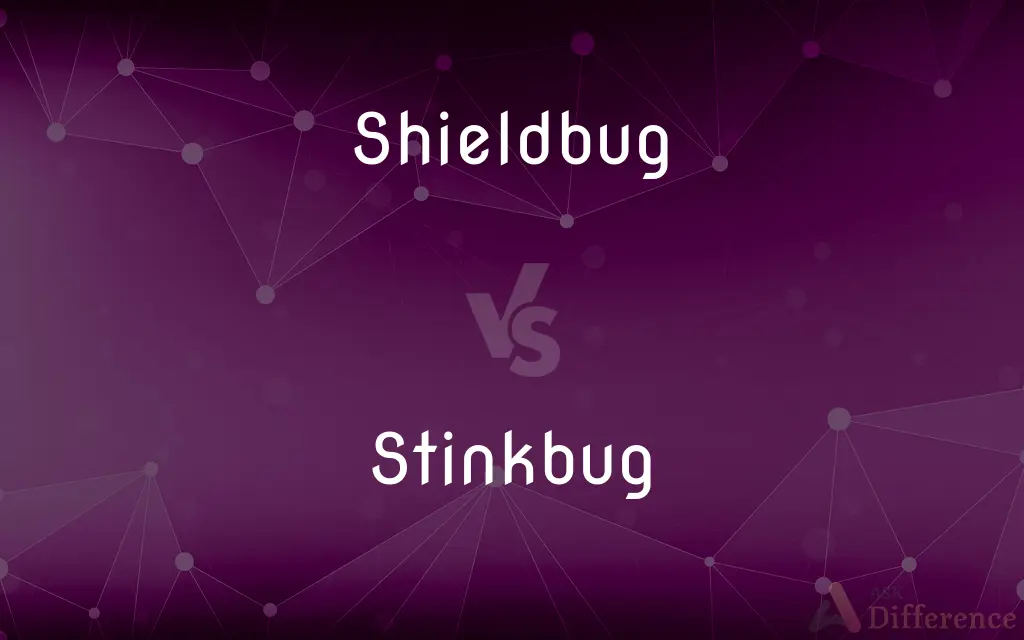Shield Bug vs. Stink Bug — What's the Difference?
By Tayyaba Rehman & Maham Liaqat — Updated on March 10, 2024
Shield bugs, known for their shield-like shape, encompass various species, including stink bugs, which are named for their ability to emit a foul odor when disturbed.

Difference Between Shield Bug and Stink Bug
Table of Contents
ADVERTISEMENT
Key Differences
Shield bugs are characterized by their distinctive shield shape, found across many habitats worldwide. While stink bugs, a subset of shield bugs, are specifically noted for releasing a pungent smell as a defense mechanism against predators.
The term "shield bug" refers broadly to members of the Pentatomidae family, which includes a diverse range of species with varying habits and appearances. On the other hand, "stink bug" is used more narrowly to describe those species within the family that produce a noticeable odor through glands located on their thorax.
Shield bugs can be found in various colors and sizes, adapting to their environments by feeding on plants, fruits, and sometimes other insects. Whereas stink bugs are often associated with agricultural damage, feeding on crops and ornamental plants, leading to significant economic losses.
In terms of pest control, both shield and stink bugs can pose challenges. However, stink bugs are particularly targeted due to their impact on agriculture and the nuisance they create in homes and gardens. On the other hand, not all shield bugs are considered pests, with some playing beneficial roles in their ecosystems.
Biologically, all stink bugs are shield bugs, but not all shield bugs are stink bugs. This distinction highlights the specific behavior of stink bugs within the broader classification of shield bugs. On the other hand, understanding the differences between these groups can aid in pest identification and management strategies.
ADVERTISEMENT
Comparison Chart
Definition
A broad category of bugs known for their shield-like shape.
A specific group within shield bugs known for emitting a foul odor.
Family
Pentatomidae
Pentatomidae (a subgroup within shield bugs)
Defensive Behavior
Varies among species; not all have a notable defense mechanism.
Characterized by the release of a foul odor when threatened.
Diet
Includes plant sap, fruits, and sometimes other insects.
Primarily plant sap, causing more significant agricultural damage.
Impact on Humans
Mostly neutral, but some species can be garden pests.
Often considered pests due to their smell and potential for crop damage.
Compare with Definitions
Shieldbug
Some species are considered beneficial to gardens.
Certain shield bugs help control the population of more harmful insects.
Stinkbug
Often associated with agricultural damage and invading homes.
Stink bugs are notorious for damaging fruits and vegetables.
Shieldbug
Insects known for their shield-like shape, varying in color and size.
The green shield bug is a common sight in gardens.
Stinkbug
Stink bugs are part of the larger Pentatomidae family.
Despite their reputation, not all Pentatomidae members are stink bugs.
Shieldbug
Found in various environments, feeding on a wide range of plants.
Shield bugs can be seen on trees, shrubs, and flowers.
Stinkbug
A type of shield bug known for emitting a foul odor when disturbed.
The brown marmorated stink bug has become a significant pest in many regions.
Shieldbug
Their appearance can be quite striking, with vibrant colors.
The red and black shield bug is often photographed due to its vivid coloration.
Stinkbug
They use their smell as a defense mechanism against predators.
When threatened, a stink bug releases a scent from glands near its thorax.
Shieldbug
Members of the Pentatomidae family, not all of which produce odors.
Some shield bugs contribute to the ecosystem by preying on other pests.
Stinkbug
Their presence in homes can be a nuisance due to their smell.
Homeowners often seek ways to repel stink bugs in the fall.
Shieldbug
Alternative spelling of shield bug
Stinkbug
Any of numerous hemipteran insects of the family Pentatomidae, having a broad, flattened body and emitting a strong odor from glands in the abdomen.
Stinkbug
Any of several insects, usually shield-shaped, possessing a gland that produces a foul-smelling liquid, usually containing aldehydes which they use to discourage predators.
Stinkbug
(entomology) Any of various insects of the Hemiptera order (the "true bugs"), in the Heteroptera suborder, principally in the superfamilies Pentatomoidea and Coreoidea.
Stinkbug
(US Southwest) A pinacate beetle or stink beetle (genus Eleodes) that releases a pungent odor when threatened.
Common Curiosities
How do I identify a stink bug among shield bugs?
Stink bugs can be identified by their tendency to release a noticeable odor when disturbed, a trait that is less common or absent in other shield bugs.
Can shield bugs and stink bugs be found in the same habitats?
Yes, both can often be found in similar environments, including gardens, farms, and natural habitats, although their specific preferences may vary.
Are all stink bugs harmful to crops?
Many stink bugs are considered pests due to their feeding habits, which can damage a wide range of agricultural crops.
Are there beneficial shield bugs?
Yes, some shield bugs are considered beneficial as they prey on other insects that are harmful to plants.
Do shield bugs and stink bugs have natural predators?
Both have natural predators, including birds, spiders, and parasitic wasps, which help control their populations.
Why are stink bugs considered a bigger problem than other shield bugs?
Stink bugs are often more problematic due to their dietary habits, which can cause significant damage to crops and their tendency to invade homes.
What makes stink bugs different from other shield bugs?
Stink bugs specifically emit a foul odor as a defense mechanism, a trait not shared by all shield bugs.
What is the purpose of the odor produced by stink bugs?
The odor serves as a defense mechanism to deter predators and protect the bug from being eaten.
How can I manage stink bugs in my garden or home?
Management strategies include sealing entry points in homes, using traps, and applying appropriate pesticides in gardens while being mindful of non-target effects.
What do shield bugs eat?
Shield bugs have a varied diet including plant sap, fruits, and sometimes other insects, depending on the species.
What are some common features of shield bugs?
Common features include their shield-like shape and, in some species, the ability to produce a defensive odor.
What should I do if I find stink bugs in my home?
To manage stink bugs in the home, consider sealing cracks, using traps, and avoiding squishing them to prevent releasing their odor.
How do stink bugs affect agriculture?
Stink bugs damage crops by feeding on fruits and vegetables, leading to economic losses for farmers.
Can shield bugs and stink bugs be beneficial to ecosystems?
While stink bugs are often pests, some shield bugs play beneficial roles in their ecosystems, such as controlling pest populations.
How can I differentiate between different types of shield bugs?
Differentiation can be based on physical characteristics, behavior (such as odor production), and habitat preferences.
Share Your Discovery

Previous Comparison
Itemise vs. Itemize
Next Comparison
Kindness vs. ThoughtfulnessAuthor Spotlight
Written by
Tayyaba RehmanTayyaba Rehman is a distinguished writer, currently serving as a primary contributor to askdifference.com. As a researcher in semantics and etymology, Tayyaba's passion for the complexity of languages and their distinctions has found a perfect home on the platform. Tayyaba delves into the intricacies of language, distinguishing between commonly confused words and phrases, thereby providing clarity for readers worldwide.
Co-written by
Maham Liaqat













































